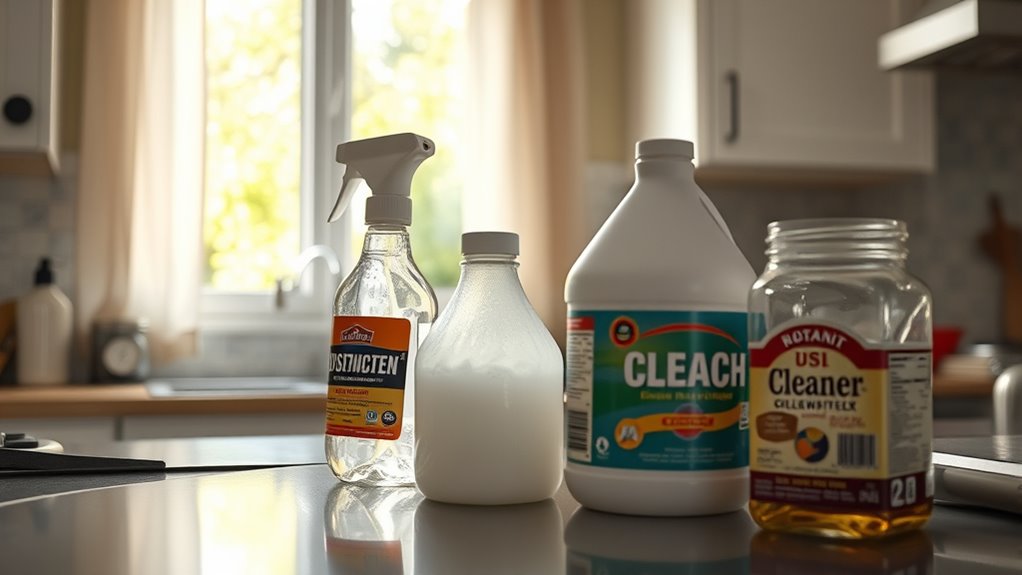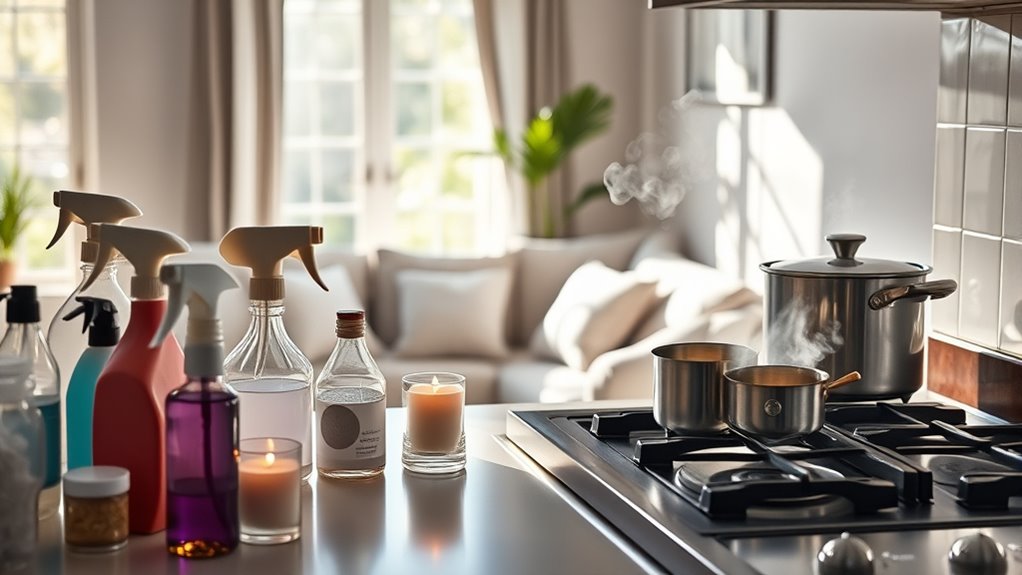VOCs in your home come from everyday sources like cleaning products, paints, furniture, personal care items, and appliances. Activities like renovation, using air fresheners, or practicing hobbies can release harmful chemicals too. Mold and outdoor pollution also contribute. To reduce VOCs, switch to natural or low-VOC products, guarantee proper ventilation, and address moisture issues. Exploring these options further will help you create a healthier, safer home environment.
Key Takeaways
- Household products like cleaning agents, air fresheners, and personal care items emit VOCs during use.
- Painting, remodeling, and new furniture off-gas VOCs over time, especially if poorly ventilated.
- Building materials such as pressed wood, carpets, and upholstery release VOCs through off-gassing.
- Combustion appliances, fireplaces, and heaters produce VOCs from burning fuels and gases.
- Mold growth in damp areas releases biological VOCs, contributing to indoor air pollution.
Common Household Cleaning Products

Many common household cleaning products release volatile organic compounds (VOCs) that can affect indoor air quality. These products often contain chemicals like ammonia, bleach, and synthetic fragrances, which emit VOCs during use. To reduce exposure, consider switching to natural cleaning options or homemade solutions. Vinegar, baking soda, and lemon juice can effectively clean surfaces without introducing harmful fumes. Using natural cleaning methods not only minimizes VOC emissions but also creates a healthier environment for you and your family. Always read labels carefully and opt for eco-friendly brands when possible. Regularly ventilate your home during and after cleaning to help dissipate VOCs. Additionally, selecting cleaning products with lower VOCs content can further improve indoor air quality and promote a safer, cleaner living space.
Indoor Painting and Renovation Activities

Indoor painting and renovation projects can substantially impact your home’s air quality by releasing volatile organic compounds (VOCs) into the environment. Paint fumes are a common source of VOCs, and prolonged exposure can cause headaches, dizziness, and respiratory issues. Renovation hazards extend beyond paint; adhesives, varnishes, and solvent-based products emit VOCs that linger long after the work is done. To reduce risks, choose low-VOC or zero-VOC paints and guarantee proper ventilation during and after your projects. Wearing masks and using fans can help disperse harmful fumes more quickly. Remember, even small renovation tasks can introduce significant VOCs, so taking precautions minimizes health risks and keeps your indoor air cleaner. Silly tantrums often occur, adding humor to family photoshoots and making the experience more memorable.
Building Materials and Furnishings

Your choice of building materials and furnishings can considerably impact indoor air quality. Items like new paint, pressed wood products, and upholstered furniture often emit VOCs that linger in your home. Being mindful of these materials helps you reduce your exposure and create a healthier environment. For instance, choosing products with low-VOC emissions can significantly improve indoor air quality.
New Paint and Coatings
When you choose new paint or coatings for your home, it’s important to be aware that many contain volatile organic compounds (VOCs) that can off-gas into the indoor environment. These paint fumes release coating volatile compounds that can linger long after application, potentially causing headaches, dizziness, or respiratory issues. Low-VOC or zero-VOC paints are better options, as they emit fewer harmful chemicals. Always ensure proper ventilation during and after painting to reduce VOC buildup. Additionally, choosing water-based paints over solvent-based options can notably decrease VOC emissions. Avoid storing or opening cans in enclosed spaces, and allow ample drying time before occupying the room. Being mindful of the VOC content in your new paint helps create a healthier indoor environment. Understanding indoor air quality and how building materials impact VOC levels can further help you maintain a safer home environment.
Pressed Wood Products
Pressed wood products, such as particleboard, plywood, and MDF, often contain formaldehyde-based adhesives that can off-gas volatile organic compounds into your home. These composite materials are common in furniture, cabinetry, and flooring. Over time, the formaldehyde releases VOCs, which can contribute to indoor air pollution and health issues like respiratory irritation. To reduce exposure, choose pressed wood products labeled low-VOC or formaldehyde-free. Increasing ventilation during and after installation helps clear out VOCs. Sealing surfaces with a high-quality, VOC-blocking finish can also limit emissions. Being aware of the materials used in your home allows you to make informed choices that improve indoor air quality and create a healthier living environment.
Upholstered Furniture Materials
Upholstered furniture materials often contain foam, fabric treatments, and adhesives that can emit volatile organic compounds (VOCs) into your home. These emissions can contribute to indoor air pollution, affecting your health over time. When choosing upholstered furniture, consider the materials used, as some fabric materials and foam cores release VOCs more than others. New furniture, in particular, tends to emit higher levels of VOCs, which decrease with ventilation. To reduce exposure, opt for low-VOC or VOC-free fabric materials and ask manufacturers about their emission standards. Properly ventilate new furniture before bringing it indoors. Regular cleaning and air purifiers can also help minimize VOC levels from upholstered furnishings. Staying informed about your furniture’s materials can improve your indoor air quality considerably. Additionally, selecting materials with low VOC emissions can further reduce indoor air pollution.
Personal Care and Beauty Products

Have you ever considered how your daily beauty routine might expose you to harmful VOCs? Many personal care and beauty products contain VOCs from ingredients like fragrances, preservatives, and dyes. To reduce your exposure, look for products with natural ingredients and ingredient transparency. These options often avoid harmful chemicals that off-gas into your home air. Being aware of cookie consent practices and product ingredient transparency can help you make informed choices for a healthier home environment. Here’s a quick comparison:
| Product Type | Common VOCs | Tips for Safer Use |
|---|---|---|
| Perfumes & Colognes | Synthetic fragrances | Choose fragrance-free or natural options |
| Lotions & Creams | Preservatives, dyes | Read labels for transparency |
| Hair Products | Solvents, alcohols | Opt for natural ingredients |
Switching to products with clear ingredient labels can make a real difference in your home’s VOC levels.
Combustion Sources: Smoke and Gas Appliances

When you use gas stoves or fireplaces, harmful VOCs can be released into your home’s air. These emissions come from burning fuels, creating fumes that may affect your health. Understanding how to manage these sources helps keep your indoor environment safer. Additionally, being curious about air quality can motivate you to explore solutions for reducing indoor pollutants.
Gas Stove Emissions
Gas stoves are a common source of indoor air pollution because their combustion releases pollutants like nitrogen dioxide (NO₂), carbon monoxide (CO), and particulate matter directly into your kitchen. These gas stove emissions can impact your indoor air quality and pose health risks if not properly managed. Ensuring proper ventilation and maintaining combustion safety are vital to minimize exposure. Poorly ventilated stoves increase pollutant levels, especially during long cooking sessions. Using exhaust fans or range hoods helps remove harmful gases. Regularly checking for leaks and maintaining appliances supports combustion safety and reduces VOCs. Be mindful of the following: – Proper ventilation during cooking – Using range hoods or exhaust fans – Regular appliance maintenance – Monitoring for gas leaks. Additionally, selecting vetted and high-quality cookware can help reduce the release of additional indoor pollutants during cooking.
Fireplace and Heater Fumes
Fireplaces and heaters that burn fuels like wood, coal, or natural gas release fumes and particulate matter directly into your home, affecting indoor air quality. Fireplace fumes contain VOCs, carbon monoxide, and other pollutants that can cause health issues over time. Heater emissions, especially from older or poorly vented units, contribute to indoor air pollution with similar harmful compounds. If you use a wood-burning fireplace or gas heater regularly, you might notice lingering odors and increased indoor pollutants. Proper maintenance, such as regular chimney cleaning and ensuring good ventilation, reduces these emissions. Consider upgrading to cleaner-burning appliances or adding air filtration systems to minimize exposure to fireplace fumes and heater emissions, helping you breathe easier and improve your home’s air quality.
New Furniture and Carpets

New furniture and carpets often release volatile organic compounds (VOCs) into your home environment. This process, known as furniture off gassing, occurs when VOCs evaporate from new materials, affecting indoor air quality. Similarly, carpet chemical emissions happen as new carpets release VOCs from adhesives, dyes, and backing materials. These emissions can cause eye, nose, and throat irritation, headaches, or respiratory issues if not managed properly. To reduce VOC exposure, consider airing out new furniture and carpets before bringing them inside. Use ventilation fans and open windows regularly. Choosing low-VOC or VOC-free products can also help. Keep in mind that VOC levels tend to decrease over time as materials off gas naturally. Self Watering Plant Pots can also contribute to indoor VOC levels through certain plastics and materials used. Being proactive can make your home safer and more comfortable.
Air Fresheners and Scented Products

Many air fresheners and scented products contain hidden chemical ingredients that can release VOCs into your home. There are various types, from sprays to plug-ins, each with different risks. To stay safe, choose natural options and follow proper usage tips. Additionally, using community-supported products can help reduce exposure to harmful chemicals often found in synthetic air fresheners.
Hidden Chemical Ingredients
Hidden chemical ingredients in air fresheners and scented products can substantially impact indoor air quality. Many products lack clear chemical disclosures, making it difficult for you to know what’s truly inside. Without ingredient transparency, you might unknowingly expose yourself to VOCs and other harmful chemicals. These hidden substances can cause headaches, allergies, or respiratory issues over time. To protect yourself, look for products that prioritize ingredient transparency and avoid those with vague labels. Being aware of the ingredients helps you make healthier choices and reduce VOC levels indoors. Additionally, some products may contain unregulated chemicals, increasing the risk of exposure without consumer knowledge.
Scented Product Types
Scented products like air fresheners, candles, and plugins are common tools for creating a pleasant home environment, but they often contain VOCs and other chemicals that can harm indoor air quality. Many scented candles use paraffin wax, which releases VOCs when burned, while some air fresheners emit synthetic fragrances with potentially harmful chemicals. Essential oils are a natural alternative that can add fragrance without the same level of VOC emissions, but not all products labeled as natural are free from chemicals. Be cautious with scented candles, especially those made with synthetic fragrances, as they can release harmful compounds into your air. Choosing products carefully and understanding their ingredients helps reduce VOC exposure and improves indoor air quality. Additionally, VOC emissions from scented products can vary depending on their ingredients and usage, so being informed helps you make safer choices.
Safe Usage Tips
To minimize your exposure to VOCs from scented products, it’s important to use them thoughtfully and responsibly. Always follow manufacturer instructions and avoid overusing air fresheners and scented items. Implement proper ventilation strategies, such as opening windows or running exhaust fans when using these products, to reduce VOC buildup. Store scented products in a cool, dry place away from children and pets to prevent accidental ingestion or exposure. Keep products sealed tightly after use to prevent VOC vapors from escaping into the air. Regularly clean and air out your space to disperse any lingering fumes. By practicing safe chemical storage and ventilation, you can enjoy a fresh-smelling home while minimizing indoor VOC levels. Additionally, choosing freshly squeezed juice over processed options can help reduce your exposure to synthetic chemicals often found in commercial scented products.
Outdoor Pollution Infiltration

Have you ever considered how outdoor pollution can quietly seep into your home? Outdoor pollution infiltration occurs when pollutants like vehicle emissions, industrial fumes, or pollen enter through open windows, doors, or vents. Poor outdoor air quality can substantially impact your indoor environment, increasing VOC levels and affecting your health. Even if you’re careful about indoor sources, outdoor pollutants can bypass barriers and linger inside. To reduce infiltration, keep windows and doors closed during high pollution days, use air purifiers with HEPA filters, and ensure your home has proper ventilation. Sealing gaps and cracks around windows and doors also helps prevent outdoor contaminants from sneaking in. Staying aware of outdoor air quality reports allows you to take proactive steps to protect your indoor environment from harmful pollutants. Additionally, understanding Cost and Budgeting can help you invest in effective air quality solutions that fit your financial plan.
DIY and Hobby Chemicals

Many DIY and hobby chemicals, such as paints, solvents, glues, and hobbyist sprays, can release volatile organic compounds (VOCs) into your home air. These VOCs, often called hobby fumes, can linger and cause health issues if not properly ventilated. When working with DIY chemicals, it’s crucial to minimize exposure by choosing low-VOC or VOC-free products whenever possible. Always work in well-ventilated areas, and avoid storing chemicals in confined spaces. Proper disposal of leftover chemicals also helps reduce VOC emissions. Being mindful of hobby fumes and taking safety precautions can greatly improve your indoor air quality. For added safety, selecting safe chemical alternatives can further reduce harmful emissions and promote a healthier home environment.
Biological Sources and Mold

While managing VOCs from DIY chemicals helps improve indoor air quality, biological sources like mold can also profoundly affect your home’s air. Mold growth occurs in damp, poorly ventilated areas, leading to biological contamination that releases spores and volatile organic compounds into the air. These emissions can cause allergic reactions, asthma flare-ups, and other health issues. Mold thrives on moisture from leaks, condensation, or high humidity, making it a persistent problem. To reduce biological sources, control indoor humidity with dehumidifiers, fix leaks promptly, and improve ventilation. Regularly inspecting and cleaning areas prone to mold growth helps prevent biological contamination. Recognizing dog names that suit your pet can also contribute to a more harmonious home environment. Addressing mold issues quickly not only improves air quality but also protects your health and preserves your home’s structural integrity.
Frequently Asked Questions
How Do VOCS Affect Indoor Air Quality and Health?
VOCs can considerably impact your indoor air quality and health by releasing indoor pollutants that may cause headaches, respiratory issues, or long-term health problems. Poor air quality monitoring makes it harder to detect these harmful substances. To protect yourself, guarantee proper ventilation, reduce sources of VOCs, and consider air quality monitoring devices to keep track of pollutant levels, making your home safer and healthier.
Can Natural or Organic Products Still Emit VOCS?
Did you know that even natural or organic products can emit VOCs? While natural emissions from plants or organic chemicals are generally lower than synthetic options, they still release VOCs that can affect indoor air quality. These emissions vary based on the product and environment, so it’s important to choose carefully. Using well-ventilated spaces and low-VOC labels can help minimize exposure, even with natural or organic products.
What Are the Long-Term Effects of VOC Exposure at Home?
Long-term health risks from VOC exposure at home include respiratory issues, headaches, and even more serious conditions like asthma or neurological problems. Chronic exposure can gradually affect your overall well-being, especially if ventilation is poor or you’re exposed regularly. You might not notice immediate effects, but over time, these VOCs can build up and cause persistent health problems, emphasizing the importance of reducing indoor VOC levels.
How Can I Detect VOC Levels Inside My Home?
Think of VOC detection like a lighthouse guiding you through foggy waters; it helps you see hidden dangers. Use air quality monitors designed for VOCs to check your home’s air. These devices alert you to unsafe levels before symptoms appear. Regularly monitor your indoor environment, especially after renovations or using new products, so you can take quick action and protect your loved ones from potential health risks.
Are There Effective Air Purification Methods for VOC Removal?
You can effectively reduce VOCs with air purifiers that include VOC filters. Look for models specifically designed to target VOCs, as they trap and break down harmful chemicals. Regularly changing filters guarantees peak performance. Combining an air purifier with good ventilation helps improve air quality further. These methods make a noticeable difference, creating a safer, cleaner environment by actively removing VOCs from your home air.
Conclusion
You might think opening windows is enough to clear VOCs, but studies show fresh air alone doesn’t eliminate all indoor pollutants. Instead, reducing source use and choosing low-VOC products make a real difference. It’s like cleaning your house—you can’t just air it out; you need to tackle the source. So, next time you’re renovating or cleaning, remember: prevention beats just airing out your home. Small changes can appreciably improve your indoor air quality.









